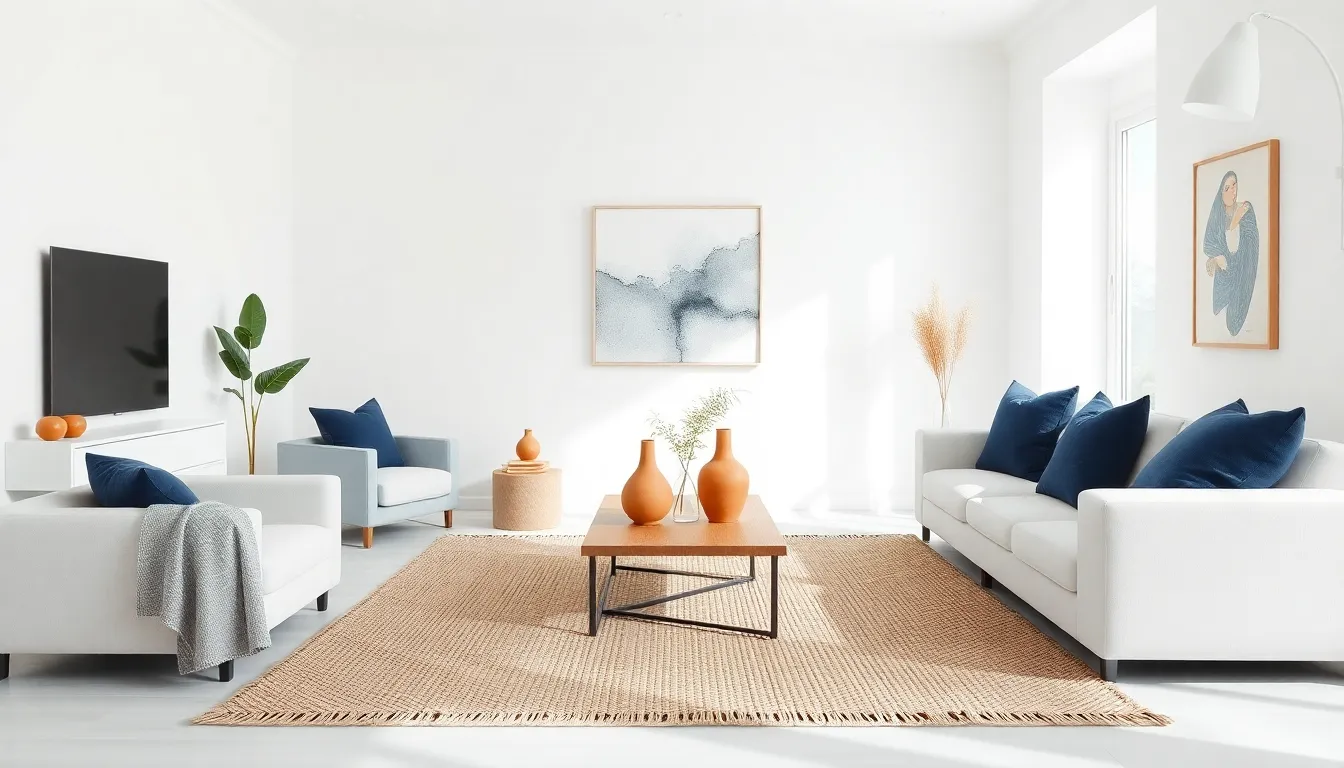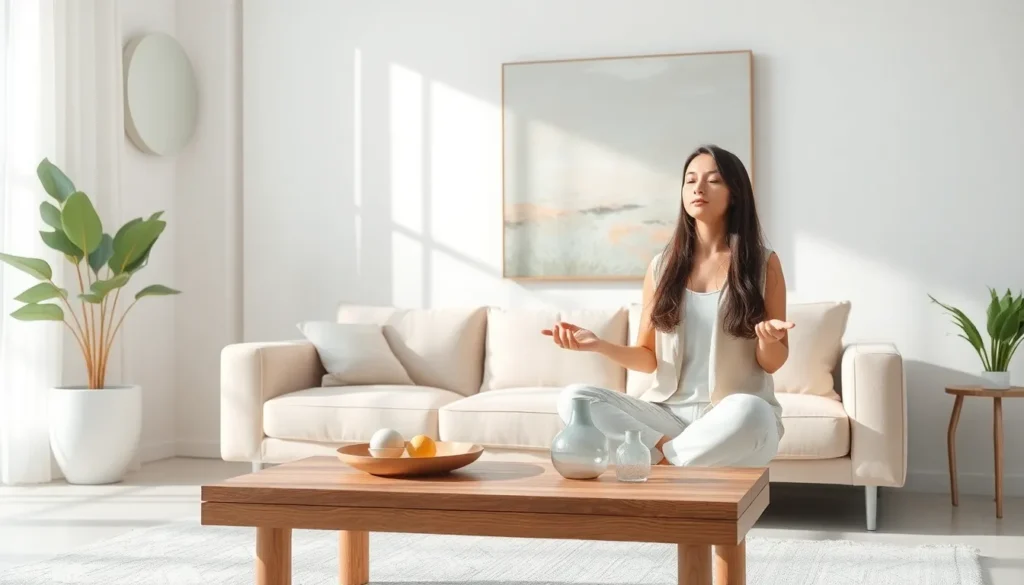In a world overflowing with stuff, embracing minimalist living room decor can feel like a breath of fresh air. Imagine walking into a space that radiates calmness and clarity rather than chaos and clutter. It’s not just about fewer items; it’s about creating a sanctuary that reflects your style without overwhelming your senses.
Table of Contents
ToggleUnderstanding Minimalist Living Room Decor Ideas
Minimalist living room decor creates a serene environment that emphasizes simplicity. This design philosophy centers on functionality while highlighting personal style.
Key Principles of Minimalism
Simplicity stands at the core of minimalist design. Fewer items in the space create a sense of freedom and tranquility. Functionality plays a key role, as every piece serves a purpose. Neutral color palettes enhance the atmosphere, fostering a calm vibe. Clean lines and open spaces further contribute to the uncluttered aesthetic. Choosing multifunctional furniture allows for efficient use of space, optimizing comfort and usability.
Benefits of Minimalist Decor
Clarity emerges as one significant benefit of minimalist decor. An organized space reduces visual noise, promoting focus and relaxation. Minimalist living rooms often lead to improved mental health due to reduced stress and distraction. Time spent cleaning and maintaining items decreases, giving more time for enjoyable activities. Incorporating fewer decor items allows for greater emphasis on quality. Sustainability becomes a factor, as fewer possessions encourage conscious consumption.
Color Schemes for a Minimalist Living Room

Color schemes play a crucial role in creating a minimalist living room. Selecting the right palette enhances the overall aesthetic while promoting tranquility.
Neutral Tones
Neutral tones dominate minimalist designs. Shades like white, beige, and gray provide a calm backdrop for the space. These colors reflect light and create an expansive feeling, making rooms appear larger and more inviting. Pairing different neutral hues creates depth without overwhelming the senses. Accentuating with varying textures—such as a soft throw or a woven rug—adds warmth while maintaining a clean look. Incorporating natural materials like wood can also enhance the neutral palette, introducing subtle warmth and organic elements.
Accent Colors
Accent colors add personality to minimalist living rooms. Select bold hues like navy, emerald green, or terracotta for striking contrast against neutral backdrops. These colors draw attention to specific areas, like artwork or furniture pieces, without cluttering the overall design. Using accents in small amounts can prevent overpowering the room. Accessories, such as cushions or vases, offer an easy way to introduce these vibrant tones. Consider seasonal changes to refresh the space, allowing for temporary shifts in color while retaining the core minimalist aesthetic.
Furniture Selection for Minimalist Spaces
Furniture selection plays a crucial role in achieving a minimalist living room. Focus on pieces that enhance functionality and aesthetics without overwhelming the space.
Multi-Functional Furniture
Multi-functional furniture maximizes utility while minimizing clutter. A sofa bed serves as seating during the day and transforms into a bed for guests at night. Nested tables provide surface area when needed and tuck away when not in use. Look for ottomans with storage capacity, offering both seating and a place to store items. Additionally, a coffee table with hidden compartments keeps essentials organized and out of sight. Such versatile designs simplify living in minimalist spaces while maintaining an organized appearance.
Simple and Functional Designs
Simple and functional designs embody the essence of minimalism. Choose furniture with clean lines and unobtrusive forms that enhance rather than dominate the room. A low-profile couch or a sleek dining table allows other elements to shine, creating a serene environment. Search for well-crafted pieces that emphasize quality and durability over excessive ornamentation. Color plays a role too; neutral hues harmonize and impart a sense of calm. Emphasizing functionality ensures each piece contributes to a cohesive, uncluttered look while providing comfort and ease of use.
Minimalist Accessories and Decor
Incorporating accessories and decor in a minimalist living room is crucial for establishing a serene atmosphere. Selecting the right elements enhances simplicity and retains an uncluttered aesthetic.
Art and Wall Decor
Choosing art and wall decor for a minimalist space requires careful consideration. Focus on pieces that evoke tranquility and simplicity. Large-scale artwork can serve as a focal point, creating visual interest without overwhelming the room. Consider abstract designs or nature-inspired themes that complement the neutral palette. Frames should feature clean lines in materials like wood or metal to maintain unity. A gallery wall with a few selected pieces ensures personal expression while avoiding clutter.
Textiles and Soft Furnishings
Textiles and soft furnishings play a significant role in achieving a minimalist look. Opt for a limited selection of cushions, throws, and rugs to add comfort and warmth. Natural fibers, such as cotton and linen, contribute to a clean aesthetic while remaining inviting. Choose colors that harmonize with the overall palette, highlighting subtle textures without being distracting. Minimalist window treatments, such as sheer curtains or simple blinds, allow natural light to flow in, enhancing the serene environment.
Layout and Space Planning
Effective layout and space planning enhance the minimalist aesthetic in the living room. This approach emphasizes openness and clarity in design.
Open Concept Layouts
Open concept layouts work well for minimalist living rooms. These spaces create a seamless flow between different areas, making rooms feel larger and more inviting. Natural light thrives in open spaces, reducing the need for additional lighting. Furniture placement can focus on functionality, allowing for easy movement and promoting interaction among occupants. Consider using furnishings to define specific areas within the layout. For example, a sofa can serve as a boundary between the living space and dining area while maintaining an airy feel.
Creating Flow and Functionality
Creating flow and functionality is crucial in minimalist design. They ensure the space feels connected and practical. Each piece of furniture plays a specific role that enhances usability while minimizing clutter. When arranging furniture, prioritize pathways that encourage movement. Keep the floor clear, allowing easy access to various areas. Select pieces that offer storage solutions, like ottomans or coffee tables with compartments. These options help keep the space organized without sacrificing style. Thoughtful arrangements establish a harmonious balance between aesthetics and comfort.
Embracing minimalist living room decor can transform a space into a tranquil retreat. By focusing on simplicity and functionality individuals can create an environment that not only looks appealing but also fosters mental clarity. Thoughtfully chosen colors textures and furniture enhance the overall aesthetic while promoting a sense of calm.
The key lies in selecting pieces that serve multiple purposes and contribute to an uncluttered look. Accessories should be minimal yet impactful allowing personal style to shine through without overwhelming the senses. With intentional design choices anyone can cultivate a serene living space that reflects their unique personality while enjoying the benefits of a minimalist lifestyle.





